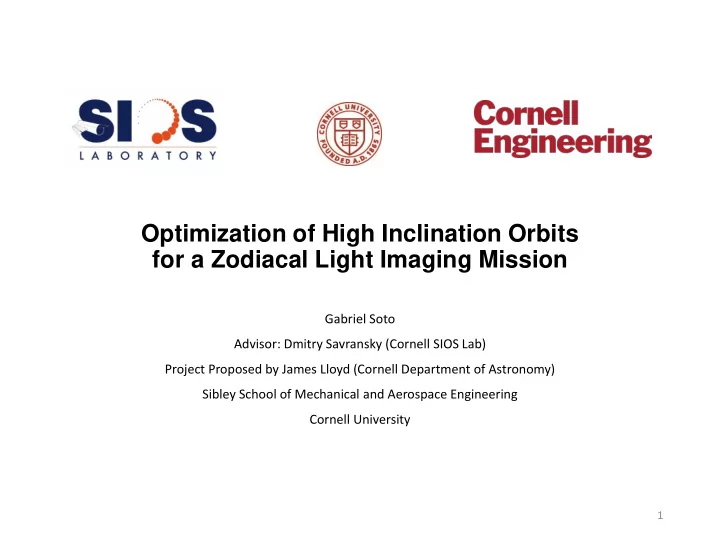

Optimization of High Inclination Orbits for a Zodiacal Light Imaging Mission Gabriel Soto Advisor: Dmitry Savransky (Cornell SIOS Lab) Project Proposed by James Lloyd (Cornell Department of Astronomy) Sibley School of Mechanical and Aerospace Engineering Cornell University 1
Zodiacal Light • Caused by interplanetary dust clouds as evidenced from IRAS (1983) • Second-most luminous source of light • Lasting structure in our solar system Photograph by: Damian Peach 2
Zodiacal Light • Spacecraft missions near Earth affected by unknown structure • Noise from zodiacal light hinders exoplanet searches Cash, Glassman, Lo & Soummer, SPIE 7731 (2010) 3
Zodiacal Light • Dust bands nearly parallel to ecliptic • Circumsolar rings resonantly locked with Earth Dermott et al. (1994) 4
Mission Requirements • Zodiacal structures observable from above ecliptic • Ulysses mission originally had equipment to image the zodiacal light • Need cost-effective spacecraft 5
Mission Requirements • Minimum orbital height of 0.1AU • IR/visible light ~3cm camera • Minimize fuel consumption ( Δ V) and mass • CubeSats currently capable of ~200m/s (VACCO Industries) • ~500m/s propulsion units in development (Aerojet Rocketdyne) 3U CubeSat Kit from Pumpkin Inc. 6
Orbital Considerations • Potential primary missions to board: • Europa Multiple Flyby Mission (2022) • Exploration Mission 1 (2018) • Telecommunications depend on distance from Earth 7
Orbital Techniques • V-infinity sphere • Magnitude determined by orbit before flyby • Two parameters in a 3-D flyby: pump and crank angles • Pump ( α ) widens orbit • Crank ( κ ) inclines the orbit Russell and Strange (2007) 8
Orbital Techniques • Cassini Example: Inner Planetary Flyby Schedule Earth Flyby 1 Venus Flyby 1 Venus Flyby 2 α = 64.92 deg α = 1.03 deg α = 22.29 deg κ = 178.08 deg κ = 175.06 deg κ = 41.56 deg Cassini Venus Earth 9
Optimization Problem • SNOPT: Sparse Nonlinear Optimizer • Minimize amount of Δv needed to achieve orbit wanted • Maximize inclination with crank angle • Maintain resonance with pump angle 10
Optimization Problem 11
Future Work • Apply to 2022 Europa Mission (Atlas V) • Determine if one flyby is sufficient • Test with different planetary flybys • Lunar • Jupiter • Earth-Venus-Earth • Propulsion and structural design of spacecraft 12
Optimization of High Inclination Orbits for a Zodiacal Light Imaging Mission Gabriel Soto Space Imaging and Optical Systems Lab Sibley School of Mechanical and Aerospace Engineering Cornell University 13
References • Dermott, S.F., et.al., “A circumsolar ring of asteroidal dust in resonant lock with the Earth” Nature Vol 369 (1994) • Russell R., Strange N. “Mapping the V - Infinity Globe” AAS 07 -277 (2007) • Sims, J.A., Longuski , J.M., “Analysis of V -Infinity Leveraging for Interplanetary Missions” AIAA (1994) • Lantukh , D.V, Russell, R.P., “V -Infinity Leveraging Boundary-Value Problem and Application in Spacecraft Trajectory Design” Journal of Spacecraft and Rockets Vol. 52 No.3 (2015) • Buffington, B., Strange, N., Campagnola , S. “Global Moon Coverage via Hyperbolic Flybys” 23 rd International Symposium on Space Flight Dynamics (2012) 14
Recommend
More recommend